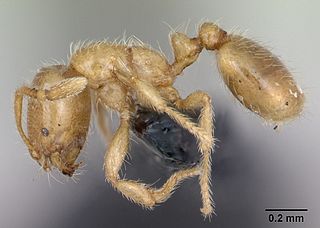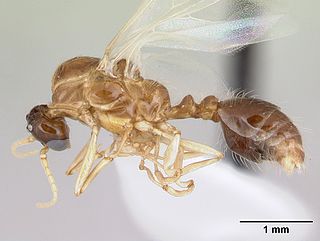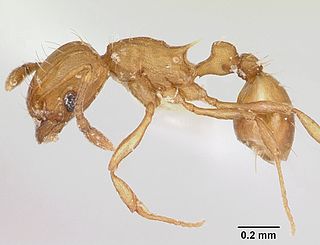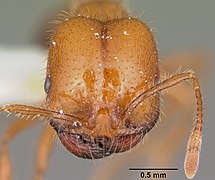Most ants are capable of biting, stinging, and spraying irritant chemicals. However, only relatively few species can harm humans; among which some can cause significant injury or, in rare cases, death. Like wasps, individual ants are capable of stinging multiple times as they do not lose their stingers.

The yellow crazy ant, also known as the long-legged ant or Maldive ant, is a species of ant, thought to be native to West Africa or Asia. They have been accidentally introduced to numerous places in the world's tropics.

Paraponera clavata, commonly known as the bullet ant, is a species of ant known for its extremely painful sting. It inhabits humid lowland rainforests in Central and South America.

Fire ants are several species of ants in the genus Solenopsis, which includes over 200 species. Solenopsis are stinging ants, and most of their common names reflect this, for example, ginger ants and tropical fire ants. Many of the names shared by this genus are often used interchangeably to refer to other species of ant, such as the term red ant, mostly because of their similar coloration despite not being in the genus Solenopsis. Both Myrmica rubra and Pogonomyrmex barbatus are common examples of non-Solenopsis ants being termed red ants.

Solenopsis invicta, the fire ant, or red imported fire ant (RIFA), is a species of ant native to South America. A member of the genus Solenopsis in the subfamily Myrmicinae, it was described by Swiss entomologist Felix Santschi as a variant of S. saevissima in 1916. Its current specific name invicta was given to the ant in 1972 as a separate species. However, the variant and species were the same ant, and the name was preserved due to its wide use. Though South American in origin, the red imported fire ant has been accidentally introduced in Australia, New Zealand, several Asian and Caribbean countries, Europe and the United States. The red imported fire ant is polymorphic, as workers appear in different shapes and sizes. The ant's colours are red and somewhat yellowish with a brown or black gaster, but males are completely black. Red imported fire ants are dominant in altered areas and live in a wide variety of habitats. They can be found in rainforests, disturbed areas, deserts, grasslands, alongside roads and buildings, and in electrical equipment. Colonies form large mounds constructed from soil with no visible entrances because foraging tunnels are built and workers emerge far away from the nest.

Solenopsis fugax is a myrmicine ant of the genus Solenopsis.

The black imported fire ant, or simply BIFA, is a species of ant in the genus Solenopsis. It was long thought to either be a subspecies or a color variation of Solenopsis invicta, but is now recognized as its own species with a demonstratively different range and living habits. BIFA seem to be more tolerant of cold and a less dominant species than RIFA. Due to the BIFA higher body content of water than the RIFA conclusions demonstrate the certain factor plays a role in their differences of living regions.

Solenopsis daguerrei is a species of parasitic ants native to Argentina and Uruguay . The young queens of the species invade the nests of other species, such as the red imported fire ant (RIFA). This is made possible by the fact that the S. daguerrei queen produces pheromones which are very similar to those produced by the queens of the host species. The young queen finds a queen of the host species and latches onto it, eating the food intended for the host queen and slowly killing it. The S. daguerrei queen then begins laying eggs. These are taken care of by the host ants, sometimes preferentially to their own brood. S. daguerrei only produce winged virgin queens and males. No workers are needed, since these are provided by the host species. The winged ants fly off to mate and invade new colonies.

Solenopsis molesta is the best known species of Solenopsisthief ants. They get their names from their habit of nesting close to other ant nests, from which they steal food. They are also called grease ants because they are attracted to grease. Nuptial flight in this species occur from late July through early fall.

The little fire ant, also known as the electric ant, is a small, light to golden brown (ginger) social ant native to Central and South America, now spread to parts of Africa, Taiwan, North America, Puerto Rico, Israel, Cuba, St. Croix and six Pacific Island groups plus north-eastern Australia (Cairns). It is a very harmful invasive species.

Myrmecia esuriens, also known as Tasmanian inchman, is a species of bulldog ant native to Tasmania.

Solenopsis saevissima, commonly known in Brazil as formiga de fogo, formiga-vermelha, or formiga-lava-pes, is one of more than 185 species in the genus Solenopsis. It, along with 13 other species, is also a member of the Solenopsis saevissima species group which are popularly known as fire ants.

The red imported fire ant, or simply RIFA, is one of over 280 species in the widespread genus Solenopsis. It is native to South America but it has become both a pest and a health hazard in the southern United States as well as a number of other countries.

Trichomyrmex destructor is a species of ant in the subfamily Myrmicinae. Its common names include destructive trailing ant or Singapore ant. It is a pest species in urban areas, known for causing costly damage to structures, vehicles, and electronic devices with its chewing activity. In 2015, the species was moved from the genus Monomorium to the revised genus Trichomyrmex.

The red imported fire ant is an invasive species in Australia originating from South America but imported to Australia, New Zealand, the United States of America and several Asian and Caribbean countries. Fire ants are listed by the International Union for Conservation of Nature (IUCN) as one of the world's most invasive species.
The toxicology of fire ant venom is relatively well studied. The venom plays a central role in the biology of Red imported fire ants, such as in capturing prey, and in defending itself from competitors, assailants, and diseases. Some 14 million people are stung annually in the United States, suffering reactions that vary from mild discomfort, to pustule formation, swelling, and in rare cases, systemic reactions followed by anaphylactic shock. Fire ant venoms are mainly composed (>95%) of a complex mixture of insoluble alkaloids added to a watery solution of toxic proteins. For the Red imported fire ant Solenopsis invicta Buren there are currently 46 described proteins, of which four are well-characterised as potent allergens.

Brachymyrmex patagonicus, also known as the black rover ant, is a species of Formicine ant native to Mexico, Central America, South America, and invasive in the United States and Europe. They were first reported in St. Tammany Parish, Louisiana in 1978 from a single colony collected in 1976. It is believed that the species was introduced through New Orleans, which is a common entry point for many tropical species, but other locations such as Mobile, Alabama, or Pensacola, Florida, are also likely. For many years B. patagonicus, B. musculus, and B. obscurior were misidentified as being separate species but after a comparison of specimens from the Louisiana State University Arthropod Collection (LSUC), it was found that all three were the same species. B. patagonicus is considered a nuisance pest due to their tendency to infest man-made structures but have received a lack of attention because they do not bite, sting, or carry disease.
In ecology, a tramp species is an organism that has been spread globally by human activities. The term was coined by William Morton Wheeler in the bulletin of the American Museum of Natural History in 1906, used to describe ants that “have made their way as well known tramps or stow-aways [sic] to many islands". The term has since widened to include non-ant organisms, but remains most popular in myrmecology. Tramp species have been noted in multiple phyla spanning both animal and plant kingdoms, including but not limited to arthropods, mollusca, bryophytes, and pteridophytes. The term "tramp species" was popularized and given a more set definition by Luc Passera in his chapter of David F William's 1994 book Exotic Ants: Biology, Impact, And Control Of Introduced Species.

An ant supercolony is an exceptionally large ant colony, consisting of a high number of spatially separated but socially connected nests of a single ant species, spread over a large area without territorial borders. Supercolonies are typically polygynous, containing many egg-laying females. Workers and queens from different nests within the same supercolony can freely move among the nests, and all workers cooperate indiscriminately with each other in collecting food and care of the brood, and show no apparent mutual aggressive behavior.




















